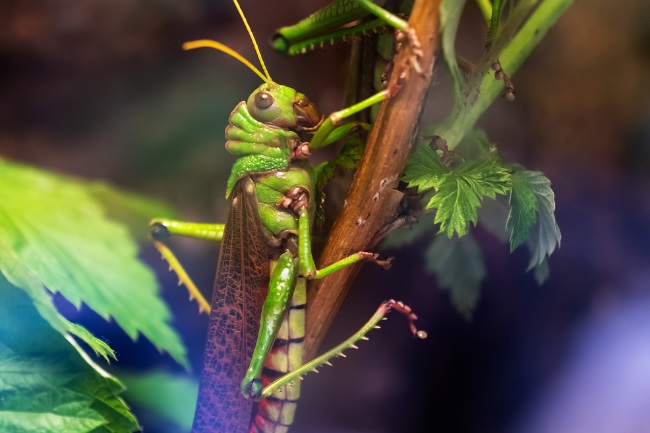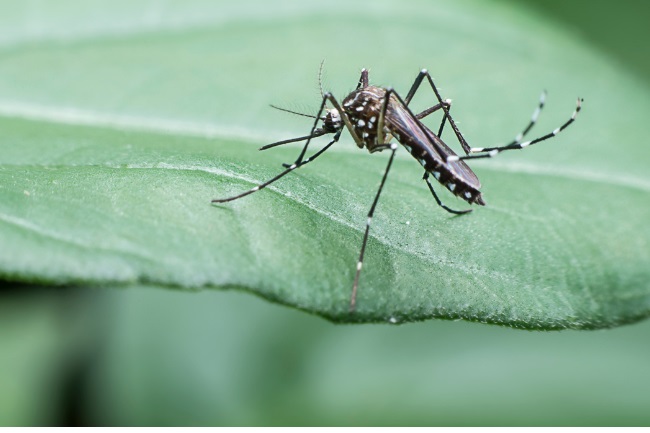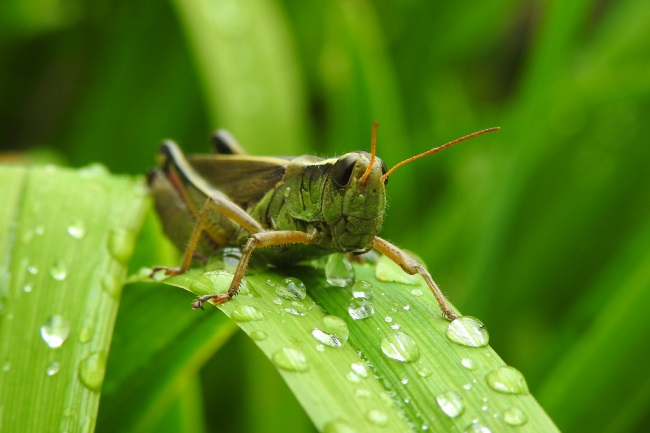Grasshoppers are predominantly herbivores, eating primarily grasses but also other vegetation. They will also take advantage of fruits, seeds and flowers. Although generally not carnivores, they will eat dead insects they find in their path. Like many insects, they do not actively drink water, getting plenty of moisture from the plants they eat.
Contents
What do grasshoppers eat?

Grasshoppers are primarily herbivorous, eating the leaves of plants, particularly grasses. Additionally, they eat seeds, flowers and fruits. Most are not fussy in what they eat, feeding on whatever they come across. Both adult and juvenile grasshoppers eat broadly the same diet, though nymphs have smaller mouthparts, meaning they cannot handle some of the denser or tougher vegetation.
Though grasshoppers are primarily vegetarians, many species also take advantage of meat when it’s easy to come by. Grasshoppers are not hunters, and most wouldn’t try to capture and kill other insects. However, they will sometimes eat already dead insects that they find in their path. The plains lubber is a slight exception, this large American grasshopper known for its inclination towards a meaty meal when it can get one.
| Food Sources | Description |
|---|---|
| Grasses | Various types of grasses, including wheat, barley, and oats |
| Leaves | Leafy vegetation such as shrubs, herbs, and tree leaves |
| Crops | Agricultural crops like corn, soybeans, and alfalfa |
| Weeds | Wild plants and weeds found in fields and meadows |
| Vegetables | Garden vegetables like lettuce, cabbage, and spinach |
| Flowers | Flowering plants, especially those with tender foliage |
| Bark and Twigs | Bark, twigs, and small branches of trees and shrubs |
| Seeds | Some grasshopper species feed on seeds, especially in late summer and fall |
| Mosses and Lichens | Certain grasshopper species may consume mosses and lichens |
Grasshoppers have also been known to turn cannibal, mainly when resources are scarce or if they come across grasshoppers that have moulted and are therefore vulnerable. Locusts, a type of grasshopper, are particularly meat hungry when external pressures cause them to become gregarious. In this more aggressive guise, they will eat other insects, roadkill, and even try to nip at their neighbours.
How do grasshoppers eat?
Like many insects, grasshoppers have a set of mandibles with which they can tear at their food and break it into chunks. They also have the maxilla that helps with further chewing. Behind that, they have a labium and labrum, which form the upper and lower lips. Once they’ve chewed up their food, it moves down through their digestive system, from the foregut, to the midgut and finally into the hindgut.
When do grasshoppers eat?

Like caterpillars, grasshoppers are eating machines. Most species live less than a year, hatching as eggs in the spring and growing throughout the year till they die in the winter. Throughout this period, they eat as much as they can in order to proliferate and become a viable potential mate.
Many grasshopper females select their mate by listening to his song. From this song, they can get information such as how strong and healthy he is. Females will be looking for the fittest male they can find to make sure their offspring have the best genes possible. Therefore, not getting enough to eat could cost a grasshopper dearly when passing on his genes. For females, too, they need to be as strong as possible to cope with the demanding task of produce offspring.
Grasshoppers will therefore start eating as soon as they hatch and largely not stop till they die. Most species are active during the day, meaning that’s when they will mostly be feeding.
Also read: How do Grasshoppers Reproduce? (Eggs & Mating Explained)
Do grasshoppers eat mosquitoes?

Grasshoppers primarily eat vegetation but will take advantage of dead insects if they come across them. This means that most grasshoppers would eat a dead mosquito if given a chance. Green grasshoppers have been observed eating mosquitoes, as have plains lubbers. Due to a grasshopper’s relatively slow reflexes, apart from their famous jump, it is unlikely they would have the speed or agility to catch a mosquito unless it was trapped or injured. This means that most that these bloodsuckers probably have little to fear from the average grasshopper.
Do grasshoppers eat ants?
Grasshoppers would happily eat a dead ant if they found it in their path, but when it comes to living ones, they would much rather put a healthy hop or two between themselves and this particular foe. Although ants may be small, they have strength in numbers, and many ant species consider grasshoppers fair game for a tasty snack.
Once an ant has located a grasshopper, it can give out chemical signals to call others to them. The ants can then pin the grasshopper down and carry him or her back to their nest, or even worse, begin dismembering the poor insect alive. Grasshoppers are particularly vulnerable after they have moulted. If found in this state, before their new exoskeleton has hardened, it can be game over for the grasshopper.
What do grasshoppers drink?

Grasshoppers, like all living things, need water to survive. However, like many herbivorous insects, they get any moisture they need from the vegetation they eat. This doesn’t mean they won’t actively drink at times, but usually, this is simply slurping up morning dew or a little rainwater from a leaf’s surface, rather than going out of their way to drink at the water’s edge.
| Water Sources | Description |
|---|---|
| Dew | Grasshoppers can obtain moisture from dew on plants in the early morning |
| Rainfall | Drinking water droplets from rainstorms and showers |
| Moisture in Plants | Extracting moisture from plant tissues, including leaves and stems |
| Puddles | Small puddles or stagnant water sources on the ground |
| Streams and Rivers | Grasshoppers may occasionally access water bodies for drinking |
| Moist Soil | Absorbing moisture from damp soil, especially after rainfall |
The grasshopper buffet
One of the things that make grasshoppers so successful is that the world is their buffet table. Because of their generalist nature, they can find food almost wherever they go. From munching on a grass stem to chewing on flower petals, there’s usually plenty of food around to satisfy them.
This is also why they are such an essential part of the food web. For all those hungry carnivores, for whom a mouthful of grass simply won’t cut it, a good supply of grasshoppers can do wonders. Many people even think grasshoppers may one day replace cows as our primary protein source. Perhaps our herds will one day be hopping rather than mooing.

